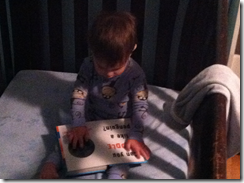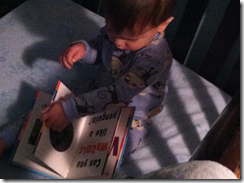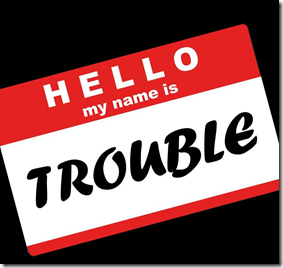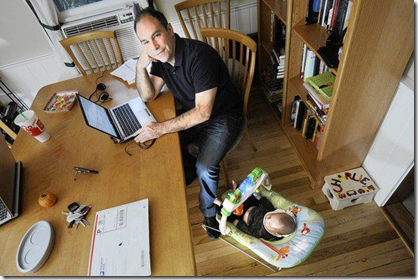Matthew Dicks's Blog, page 407
April 8, 2014
Love me some angry bigots
A beautiful campaign, followed by a brilliant response to a bunch of bigots.
Bravo, Honey Maid.
Graham crackers may have the consistency of drywall, but they taste delicious, and Honey Maid is now my permanent graham cracker of choice.
The New York Times gets haiku all wrong, and I’m infuriated. Probably more than I should be.
The New York Times has been publishing “serendipitous haikus” for the last couple years on a Tumblr called Times Haiku. An algorithm designed to detect potential haikus in text periodically scans the New York Times home page for newly published articles. Then it scans each sentence looking for potential haikus by using an electronic dictionary containing syllable counts.
While I am thrilled that a newspaper would support the writing and publishing of poetry, I’m rarely impressed by these haikus, knowing that they are only based upon the arcane syllable structure that is often taught in elementary school but does not actually define a haiku.
The Times acknowledges this limitation.
A proper haiku should also contain a word that indicates the season, or “kigo,” as well as a juxtaposition of verbal imagery, known as “kireji.”
Unfortunately, these are conditions that their algorithm cannot detect, but they are far more important than the syllable rule, which isn’t an actual rule. While I am inclined to ignore the rule about indicating a season when writing a haiku, it’s the turn or the juxtaposition of verbal imagery that makes a haiku compelling.
Without it, a haiku is merely a collection of words with a specific set of syllables.
Knowing that the Times was relying on an algorithm to produce their Haiku Tumblr, I had no complaint. They weren’t pretending that these were good haikus. It was more of a clever experiment. A fanciful exercise.
It never produced something like this:
a world of dew,
and within every dewdrop
a world of struggle
- Issa
Or this:
I kill an ant
and realize my three children
have been watching.
-Kato Shuson
But that was okay. I was glad an algorithm can’t write good poetry.
I can’t exactly write good haiku either. My best attempt is probably this one:
As a little child
You held my small hand in yours.
Now I walk for you.
-Matthew Dicks
But this week The New York Times put out a call to its readers for haikus.
For National Poetry Month, City Room hosted the New York City Haiku Challenge. We looked for original haiku that told us a little bit about New York City.
We plan to publish a selection of entries that moved us in some way — that made us laugh, think, reflect, smile, blush or even fume. We plan to illustrate the best ones with Times photographs.
I was excited about the idea. I enjoy writing haiku. I intend on having my students write haiku.
But the Times self-described “101 guide on writing a haiku” could have been taken from a first grade book on the subject:
Only three lines.
First line must be five syllables.
Second line must be seven syllables.
The third line must be five syllables.
Punctuation and capitalization are up to you.
It doesn’t have to rhyme.
It must be original.
Where is the call for juxtaposition? Why publish a guide for writing haiku that leaves out the essence of haiku? The part that actually matters?
I know I shouldn’t be infuriated by something so small, but I am.
April 7, 2014
Casual Friday EVERYDAY could save the world (and your soul)
I have argued for years that formal dress codes and formal dress expectations are ridiculous.
The idea that men go to work every day in a coat and tie, even when it’s 85 degrees outside, is insane.
Neckties are insane in all circumstances. Wrapping your neck in an unnecessary floral noose is insane.
I stopped wearing ties about six years ago. Other than my sister-in-law’s wedding and two weddings that I officiated, I have not worn a tie in that time. I only wear a suit if I am attending a wedding or another formal situation (an interview, for example) where my lack of a suit might impede my success.
Even then, failing to comport to the expected dress code is often irrelevant and unnoticed, as I have argued here before.
If you are a person who thinks that formal dress is ridiculous but worries about the impression that you may be making, I have hope for you:
The United Nations panel on climate change, along with researchers at Lancaster University, are recommending that we abandon the stupidity of a suit and tie in an effort to curb climate change.
That’s right. Stop dressing like a mindless automaton who the sixteen year-old version of you would have despised and you can do your part to save the world.
Currently, heating and cooling systems in the office and at home are designed to provide comfortable conditions for people wearing lightweight clothing, such as suits.
As more people wear casual, thicker clothing, these buildings will need less energy.
‘There is no doubt that the move away from formal office wear towards jeans, hoodies and more casual clothes is reducing the need for workplaces to be heated to the same degree,’ said Professor Elizabeth Shove from the research center.
‘And in hot climates, why not change dress codes rather than cooling buildings to counter the effect of wearing a suit and tie? These are not entirely fanciful questions.’
Not fanciful at all.
How many times have you seen this happen:
A man and a woman arrive at a formal affair. The man is wearing a suit and tie, which amounts to more clothing than he ever wears in his regular life. As a result, he is warm and uncomfortable. If there is dancing at this affair, he will likely perspire as much as he would while working out at the gym.
At the same time, his female companion is wearing a little black dress. Because the room is being cooled for the men in their formal attire, the woman is cold. Her arms are covered with goose bumps. As a result, she eventually dons the suit coat of her male counterpart.
By the way, if dancing is involved, she is likely wearing shoes that will need to be removed in order to dance.
As a wedding DJ, I watch this bizarre ritual all the time. Men and women dress in ways that deny themselves comfort.
It turns out that not only is it stupid, but it’s hurting our planet.
Around half the energy used in buildings is used to keep them at this temperature, all over the world, regardless of the weather outside.
If we all decided to dress for comfort rather than some arcane sense of what is proper or appropriate, we could make an enormous dent in CO2 transmissions.
We could also be more like the people we wanted to be when we were young and idealistic and brave.
Unnecessarily dangerous
Unnecessarily dangerous. Two perfect words to describe this.
I’ve never been the safest person in the world, but this is stupid and ridiculous.
April 6, 2014
My kids like flowers. I don’t get it.
Elizabeth Park in West Hartford, Connecticut, opened their greenhouse to the public this week, and my wife took our kids for a morning with the flowers.
As a child (and even as an adult), I can’t imagine ever enjoying a greenhouse full of flowers, but for some reason (probably the result of their mother’s influence), they had a great time. They loved looking at and smelling the flowers, and my daughter speak of them in the same way I once of Star Wars action figures and fishing lures.
I’ll never understand it, but I love it.
April 5, 2014
Suspiciously perfect start to the day
My son refused to allow me to pluck him from the crib this morning until I handed him a book and allowed him to read it first.
He’s a little less than two years-old, and yet I still felt like he had done something terribly wrong and was attempting to score points with me before I found out.
Is it wrong for me to suspect that my 22 month-old son already possesses Machiavellian intentions?
April 4, 2014
You’re not in trouble if the only consequence is a verbal reminder.
Trouble is a matter of perspective.
When a colleague, for example, tells me that he or she “got in a lot of trouble” for failing to complete a task or adhere to a policy, it almost always means that the principal has spoke to the person and warned him or her against committing the offense again.
I do not think of this as trouble. I think of this as being spoken to by your boss. I think of it as a requested change in behavior or performance.
Early in my career, when I was less subtle and considerably less wise, I would point this out to my colleagues, failing to acknowledge (or even realize) that many of these teachers are former students who graduated from high school and college with 4.0 GPAs and a list of extra-curriculum activities a mile long.
I would venture to guess that many of my colleagues never failed to hand in a homework assignment on time.
Teachers tend to be some of the best students in their classes. The ones who behaved well and always wanted to do well. The ones who loved school.
In this regard, being called into the principal’s office for a verbal reminder might be be considered trouble.
They’ve never been suspended from school. Caught selling term papers to fellow classmates. Been assigned in-school suspensions for damaging school property. Pulled fire alarms for cash. Set records for the most consecutive detentions ever.
They’ve never received a report card with an F or even a D. Never been arrested by the police. Never had the police break up a party in their apartment. They’ve never been tried in a court of law. Fired from a job or had their career threatened in any meaningful way.
In a recent, completely unscientific survey, most of them have even received a speeding ticket.
When you come from a background like mine, a verbal reminder does not constitute trouble. It’s just a reminder about what you’re supposed to be doing. A recommended change in behavior. A correction in performance.
For me, trouble is trouble. It is a behavior with an associated and meaningful consequence that will negatively impact my immediate or long-term future in a real, tangible way.
Over the years, I’ve seen this variation in perspective in my students, too. For some, a meeting with the principal about behavior is just another meeting with the principal. Five minutes later, they are behaving as if the meeting never happened.
For others, a reminder from me to pay attention in class can cause visible signs of distress for an hour or more.
Perspective is everything.
That said, even with a pristine record and lifetime of exemplary job performance, I still have a hard time accepting the idea that your boss’s expression of disapproval or request for a change in performance constitutes trouble.
If there is no tangible consequence, it’s not trouble.
But I’m smart enough today to keep these opinions to myself.
Street typography
I find this oddly calming and impressive.
Perhaps I could learn to do this in a day or two, but it would take me years to come up with a system as elegant as this.
Street typography from Tom Williams on Vimeo.
April 3, 2014
My uninspired work space
The New York Times recently featured the workspace of five writers, including a photo of each.
I’ve always felt a little envious of writers and their workspace, since mine is often the dining room table and the commotion that surrounds it:
The children, the pets, the wife, the television in the next room, the phone, the sounds of cooking from the adjacent kitchen, the buzzing, ringing and beeping of modern-day toys and the constantly encroaching detritus of everyday life.
I try to escape to libraries and similar locations from time to time, but most often, it’s the dining room.
The Hartford Courant photographer came by a couple years ago to take a photo for a story about my most recent book and captured my writing space perfectly:
The photographer asked me to show him my office, and I pointed at the table. He loved it. I told him that I would move my son and clean off the toys, mail, and other random objects on the table, but he said, “No, I love it. Just like this.”
“Sure,” I said. “It’ll make a great photo, but try writing like this.”
In reading the New York Times piece, I was happy to see that novelist Mona Simpson has a space similar to my own. After attempting to write in an office, she eventually reverted back to her home. The photograph is of her kitchen table, not unlike my own, but she also writes throughout her house.
Now I write at home. I revised the last 11 drafts, red-penciled the copy editing and marked the first-pass galleys at different places in the house; sitting on the floor next to the heating vent, on my bed, at the kitchen table, leaning back in my chair with my feet up on the desk.
Her kitchen looks a lot neater than my dining room table, but perhaps her two children are older and less destructive. Perhaps she was also smart enough to tidy up before the photographer arrived.
Either way, it was nice to see I’m not the only writer without a dedicated office filled with books, art, well appointed furniture, and an expansive view through a picture-perfect window.
Still, despite my success at the dining room table, I’d like to have an office someday. Perhaps like Simpson, I would ultimately reject it in favor of what I know, but I’m willing to give it a shot. It would be rather innovative to be able to write five whole sentences without a child asking me to play, a wife asking for a favor or a dog scratching for a bone.
Perhaps it would ruin my writing process and damage my creative process, but I’m willing to risk it. At least for a while.
A guy can dream.
April 2, 2014
I will zip no more!
My daughter zipped her coat on her own today for the first time ever.
She did it without us even asking her to try.
This marks a momentous day in her life, but more importantly, a momentous day in my life as well.
No more zipping up her coat.
Time recaptured.
Hallelujah.





















